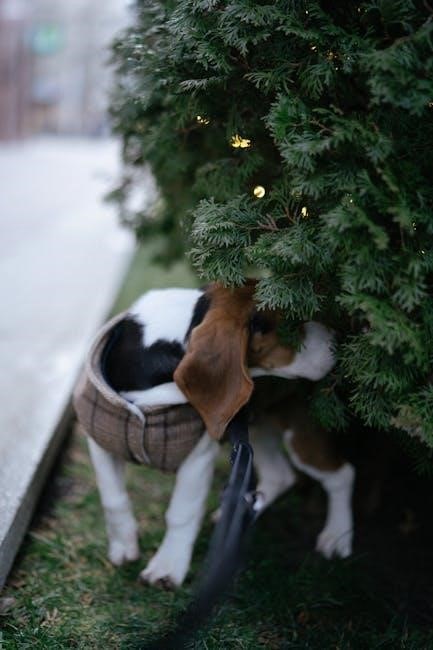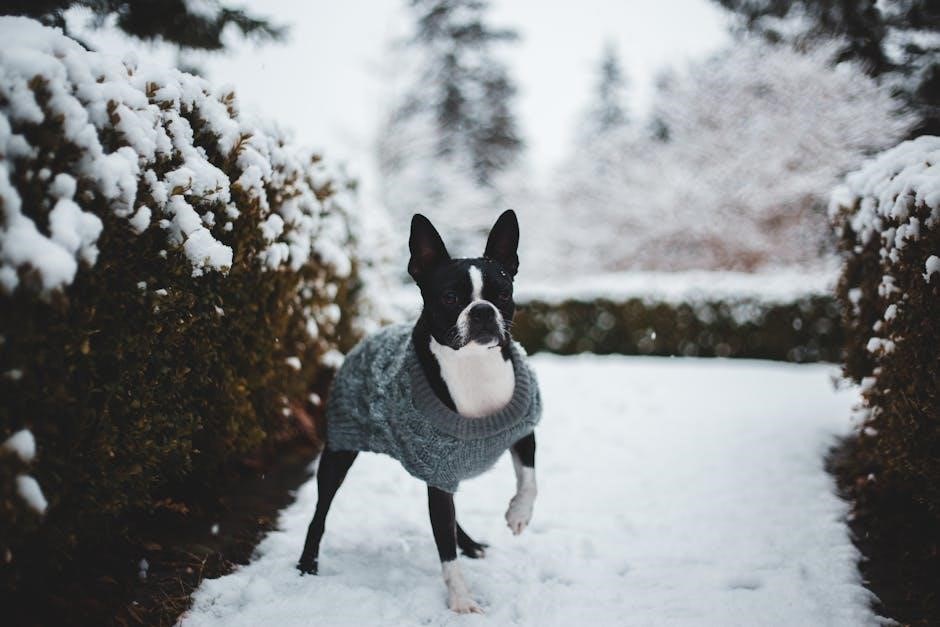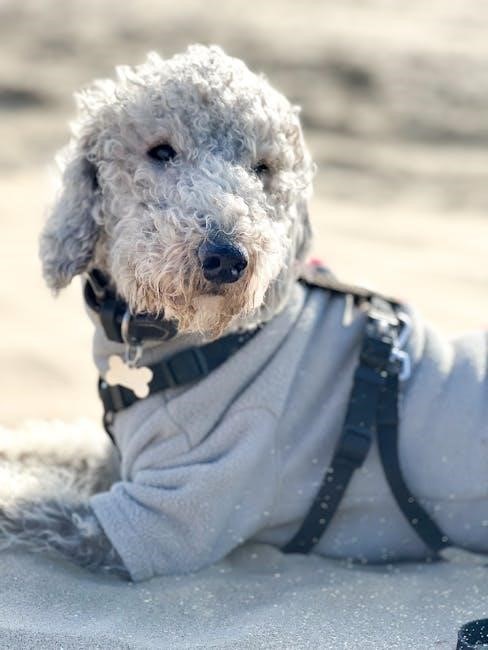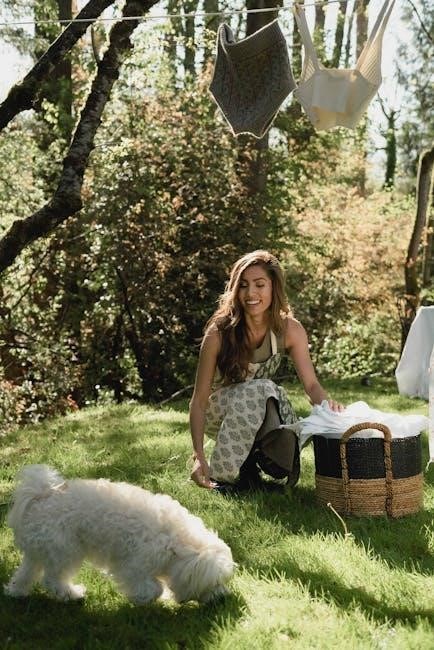
Dog clothing sizing ensures comfort and functionality, preventing health issues from poor fit. This guide helps owners navigate size charts, measurements, and fabric choices for the perfect fit, addressing various breeds, sizes, and body types to make dressing your dog easy and stress-free.
1.1 Importance of Proper Fit in Dog Clothing
Proper fit in dog clothing is crucial for your pet’s comfort and health. Clothes that are too tight can cause skin irritation, restrict movement, and lead to discomfort; Conversely, loose clothing may pose safety hazards, such as getting caught on objects. A well-fitting garment ensures your dog can move freely, breathe easily, and enjoy optimal comfort. Improperly fitted clothes can also lead to behavioral issues or stress, making accurate sizing essential for your dog’s well-being and happiness.
1.2 Brief Overview of Dog Clothing Sizes
Dog clothing sizes vary by brand and style, but most follow standard measurements based on chest circumference, length, and weight. Sizes typically range from XS to XXL, catering to diverse breeds and body types. Accurate sizing ensures optimal comfort and functionality, whether for casual wear or seasonal needs. Understanding how sizes are determined helps owners make informed choices, ensuring their dog’s clothing fits perfectly and meets their specific requirements.

Understanding Dog Body Measurements
Accurate body measurements are essential for proper fit in dog clothing. Key measurements include chest circumference, length, and weight, ensuring clothes fit comfortably and function well.
2.1 Essential Measurements for Dog Clothing
Measuring your dog accurately is crucial for the right fit. Key measurements include chest circumference, neck length, and body length. The chest is measured around the widest point, ensuring comfort. Neck length is taken at the base, while body length is from the base of the neck to the base of the tail. Weight is also considered for sizing accuracy. These measurements ensure clothes fit well without restricting movement or causing discomfort.
2.2 Tools Needed for Accurate Measurements
To measure your dog accurately, use a flexible tape measure or a soft, non-slip measuring strip. A non-slip mat can help keep your dog steady. Treats or toys can distract and calm your dog during the process. Ensure the tape measure is level and not too tight or loose. For precise results, consider having a second person assist. These tools help ensure accurate measurements, making it easier to find the perfect fit for your dog’s clothing.
2.3 How to Measure Your Dog Correctly
Measure your dog while standing on a non-slip surface. Wrap the tape measure snugly around the chest, just behind the front legs. Ensure the tape is level and not too tight. Record the circumference. For length, measure from the base of the collar to the base of the tail. Note the neck circumference if needed. Treats can help keep your dog still. Accuracy is key for proper fit, ensuring comfort and mobility in their clothing.

How to Read a Dog Clothing Size Chart
Understand the chart by matching your dog’s chest and length measurements to the size ranges. Ensure accurate alignment to avoid ill-fitting clothes and discomfort for your pet.
3.1 Understanding the Size Chart Layout
A dog clothing size chart is typically presented in a table format, listing measurements such as chest circumference, length, and weight. Sizes are categorized (e.g., XS to XL) with corresponding ranges. The layout may vary by brand, so compare your dog’s measurements to the chart carefully. Some charts include diagrams or guides to help visualize fit. Always check the brand’s specific sizing standards, as they may differ. Accurate measurements ensure the best fit for comfort and functionality.
3.2 Common Labels and What They Mean
Dog clothing size charts often use labels like XS (Extra Small), S (Small), M (Medium), L (Large), and XL (Extra Large). These labels correspond to specific measurement ranges, such as chest circumference and length. Weight ranges may also be included but are less reliable due to varying breed shapes. Labels help owners quickly identify the right size, but always cross-reference your dog’s measurements for accuracy. Understanding these labels ensures a better fit and prevents sizing errors when shopping for dog apparel.
3.3 Factors That Affect Fit
Several factors influence how dog clothes fit, including breed, body type, and muscle structure. Weight distribution, chest circumference, and length also play roles. Fabric type impacts stretchiness and comfort. Seasonal needs, like layering, may require size adjustments. Understanding these factors ensures a tailored fit, preventing issues like restricted movement or discomfort. Accurate measurements and size chart alignment are crucial for optimal comfort and functionality in dog apparel.

Fabric and Material Considerations
Fabric choice significantly impacts dog clothing fit and comfort. Popular options include breathable cotton, warm fleece, and durable waterproof materials, each catering to specific weather and activity needs.
4.1 Popular Fabrics for Dog Clothing
Common fabrics for dog clothes include breathable cotton, soft fleece, and durable nylon. Cotton is ideal for summer due to its lightweight and moisture-wicking properties, while fleece provides warmth in winter. Nylon is perfect for waterproof coats, ensuring your dog stays dry. Additionally, eco-friendly materials like bamboo and organic cotton are gaining popularity for their sustainability and gentle feel on sensitive skin. Each fabric serves a specific purpose, ensuring comfort and practicality for various activities and weather conditions.
4.2 How Fabric Choice Impacts Sizing
Fabric choice significantly affects dog clothing sizing. Stretchy materials like spandex offer flexibility, accommodating various body types and movements. Thicker fabrics, such as wool or heavy-duty nylon, may require larger sizes to ensure comfort. Conversely, lightweight fabrics like cotton or silk typically fit more snugly, allowing for precise sizing. Understanding fabric stretch and thickness helps in selecting the right size, ensuring optimal comfort and mobility for your dog without compromising on style or functionality.
4.3 Seasonal Fabrics and Their Benefits
Seasonal fabrics cater to varying weather conditions, ensuring comfort and protection. Lightweight, breathable materials like cotton or linen are ideal for summer, preventing overheating. Spring fabrics often feature moisture-wicking properties to manage wet conditions. Winter fabrics, such as fleece or wool, provide warmth and insulation. Autumn fabrics combine durability with water-resistance, protecting against cooler, wetter climates. Each fabric type is tailored to enhance comfort, functionality, and protection, making seasonal clothing choices practical and effective for your dog’s needs year-round.

Seasonal Dog Clothing Sizing
Seasonal dog clothing sizing adapts to varying weather conditions, ensuring optimal comfort and protection. Lightweight fabrics for summer, breathable materials for spring, and insulated coats for winter cater to specific seasonal needs, providing the perfect fit for different climates and activities.
5.1 Summer and Lightweight Clothing
Summer dog clothing focuses on breathability and comfort, using lightweight fabrics like cotton, linen, and mesh. These materials keep your dog cool and dry, wicking away moisture. Proper sizing ensures freedom of movement, crucial for outdoor activities. Lightweight jackets or vests with UPF protection shield against the sun. Opt for loose-fitting designs to maximize airflow. Seasonal options include cooling bandanas, breathable t-shirts, and UV-protective coats. Always prioritize comfort and functionality, ensuring your dog stays relaxed and protected during warmer months.
5.2 Winter and Heavy-Duty Coats
Winter dog coats prioritize warmth and durability, using materials like fleece, wool, and waterproof nylon. Heavy-duty designs protect against harsh weather, ensuring your dog stays dry and insulated. Proper sizing is crucial for mobility, allowing ease of movement. Look for features like adjustable straps and reflective detailing for safety. Thermal jackets and snowsuits are popular options, offering comprehensive coverage. Ensure the coat fits snugly but not too tight, balancing comfort with protection from cold and wind.
5.3 Layering Options for Different Seasons
Layering your dog’s clothing adapts to changing weather, ensuring comfort without overheating. Start with breathable base layers for cooler months, adding insulating mid-layers, and finishing with waterproof outerwear. For spring and fall, lightweight sweaters or fleece jackets suffice. Summer layers focus on moisture-wicking fabrics for heat management. Adjust layers based on activity and temperature, ensuring each piece fits well to maintain mobility. Always consult the size chart to ensure a proper fit for each layered item, promoting comfort and ease of movement.

Breed-Specific Sizing Considerations
Various dog breeds require specific sizing strategies. Pugs need extra chest room, Whippets suit slim fits, and Labradors need muscular builds considered. Always refer to a size chart for accurate fitting.
6.1 Common Breeds and Their Size Requirements
Popular breeds like Bulldogs, Dachshunds, and Greyhounds have unique size needs due to their body types. Bulldogs require roomier chests, while Dachshunds need longer, tailored fits. Australian Shepherds often fit standard sizes but may need adjustments for their athletic builds. Always consult breed-specific size charts, like those from Hurtta or Rukka, to ensure accurate measurements. Proper fit prevents discomfort and ensures functionality, making it essential to measure carefully and choose clothes designed for your dog’s specific breed characteristics.
6.2 Adjustments for Different Body Types
Dogs with muscular builds may require larger sizes, while deep-chested breeds need adjustable straps for a secure fit. Longer-bodied dogs, like Dachshunds, benefit from garments with extended torso lengths. Slim or athletic dogs may need smaller sizes or adjustable Velcro for a tailored fit. Always measure your dog individually, as body type can vary greatly, and consult breed-specific sizing charts to ensure the best fit for their unique shape and comfort needs.
6.3 How to Choose Clothes for Mixed Breeds
Choosing clothes for mixed breeds requires careful consideration of their unique size and shape. Measure your dog’s chest, neck, and length to determine the best fit. Consider their body type, as mixed breeds can inherit traits from multiple parents. Look for adjustable features like Velcro straps for flexibility. Consult size charts but be aware that mixed breeds may not fit perfectly into standard sizes. Reading reviews or reaching out to brands for sizing advice can also help ensure a comfortable, well-fitting garment.

Age-Related Sizing Tips
Age-related sizing tips help ensure your dog’s comfort and mobility at every life stage. Puppies need room for growth, adults require a maintained fit, and seniors prioritize comfort and ease of movement for their specific needs.
7.1 Puppies and Growth Considerations
Puppies grow rapidly, making frequent size adjustments necessary. Choosing clothes with adjustable features ensures a comfortable fit during growth spurts. Opt for breathable, soft fabrics to prevent irritation and allow for easy movement. Monitor measurements regularly and update sizes as needed to accommodate their developing frame. This approach ensures your puppy stays comfortable and happy while their body changes.
7.2 Adult Dogs and Maintaining Fit
For adult dogs, maintaining proper fit is crucial for comfort and health. Regularly monitor their measurements to ensure clothes aren’t too tight or loose, as body shape may change with age or activity levels. Poor fit can lead to skin irritation or restricted movement. Choose durable, breathable fabrics suitable for their lifestyle, and consider seasonal needs. Re-measure periodically to adjust sizes, ensuring a comfortable and functional fit that supports their daily activities and overall well-being.
7.3 Senior Dogs and Comfort Priorities
Senior dogs require tailored clothing that prioritizes comfort and ease of movement. Opt for soft, non-restrictive fabrics and gentle elastic to accommodate joints and sensitive skin. Avoid tight fits that may cause discomfort or limit mobility. Consider clothing with easy on/off designs for arthritic dogs. Regularly check fit to ensure comfort, as weight changes or medical conditions can affect sizing. Prioritize functionality and ease, ensuring your senior dog remains comfortable and content in their golden years.

Weight and Muscle Structure in Sizing
Weight and muscle structure significantly impact dog clothing fit. Heavier dogs may need larger sizes, while muscular builds require room for definition. Ensure measurements account for both factors to avoid restrictive clothing and ensure comfort.
8.1 How Weight Affects Clothing Fit
A dog’s weight plays a crucial role in determining the right clothing size. Heavier dogs may require larger sizes to accommodate their body mass, while lighter dogs need snugger fits to prevent loose fabric. However, weight alone isn’t always the determining factor, as body structure and muscle distribution also matter. Consulting a size chart and measuring accurately ensures the best fit, avoiding restrictive or overly baggy clothing. Proper sizing guarantees comfort and ease of movement for your dog.
8.2 Muscle Tone and Its Impact on Size
Muscle tone significantly influences dog clothing fit, as muscular dogs may require larger sizes due to their defined physique. Even if weight aligns with a size chart, muscle mass can make garments feel tighter. This is especially true for breeds like Bulldogs or Dachshunds, where muscle distribution affects fit. Always consider muscle tone when selecting sizes, as it can make clothing restrictive if overlooked. Ensure a balanced fit by checking measurements and adjusting sizes accordingly for comfort and mobility.
8.3 Balancing Weight and Muscle in Sizing
Balancing weight and muscle is crucial for accurate sizing. While weight provides a baseline, muscle tone impacts fit in specific areas like shoulders and thighs. Muscular dogs may need larger sizes despite average weight. Measure both girth and muscle areas to ensure comfort. Consult size charts that account for muscle distribution. Opt for fabrics with stretch to accommodate muscle tone. Proper fit ensures mobility and comfort, making it essential to consider both factors when selecting dog clothing.

How to Choose the Right Style
Choose styles based on your dog’s activity level and lifestyle. Active dogs need durable, breathable fabrics, while less active dogs prefer comfort and simplicity; Always consult size charts for the best fit and functionality.
9.1 Activity Level and Clothing Choice
Your dog’s activity level significantly influences clothing choice. For high-energy activities like hiking or running, opt for breathable, moisture-wicking fabrics. For moderate activities, lightweight, versatile options work best. Low-energy dogs or those lounging indoors benefit from soft, comfortable fabrics. Always consider durability and flexibility to ensure your dog can move freely. Match the clothing to their lifestyle for optimal comfort and functionality, and check size charts to ensure the best fit for their active or relaxed routine;
9.2 Style Types and Their Fit Characteristics
Dog clothing styles vary, each with unique fit characteristics. Coats and jackets often feature adjustable fasteners for a secure, weather-tight fit. Sweaters and hoodies provide a snug, casual fit, ideal for everyday wear. T-shirts and tank tops are lightweight with an elastic fit, perfect for summer. Each style is designed to balance comfort and functionality, ensuring your dog can move freely while looking stylish. Choose styles that align with your dog’s activity level and body type for the best results.
9.3 Personalizing Your Dog’s Wardrobe
Personalizing your dog’s wardrobe involves matching their clothing to their lifestyle, coat type, and your personal style. Choose colors that complement their fur and patterns that reflect their personality. Consider seasonal needs, like breathable fabrics for summer or thermal layers for winter. Accessories, such as scarves or collars, can add a unique touch. Ensure each piece prioritizes comfort and mobility while reflecting your dog’s individuality. This thoughtful approach creates a tailored wardrobe that balances style and functionality.

Troubleshooting Common Fit Issues
Identify issues like tight collars or restricted movement. Check for proper alignment and adjust sizing based on measurements. Consult size charts or professionals for tailored solutions.
10.1 Signs of Poor Fit
Recognizing a poor fit is crucial for your dog’s comfort. Look for signs like restricted movement, breathing difficulties, or visible discomfort. Check if the garment rides up, digs into the skin, or causes irritation. If your dog constantly tries to remove the clothing or shows signs of stress, it may indicate an improper fit. Addressing these issues promptly ensures your dog stays comfortable and healthy. Regularly monitor their behavior and adjust their clothing accordingly.
10.2 Adjustments for Better Comfort
If your dog’s clothing doesn’t fit well, consider adjustments for better comfort. Start by rechecking measurements and comparing them to the size chart. Loosen tight areas or opt for a larger size if necessary. Adding Velcro or elastic can improve flexibility. For minor issues, trimming excess fabric or padding can help. If discomfort persists, consult the manufacturer for exchanges or alterations. Prioritizing your dog’s comfort ensures they enjoy wearing their clothes without stress or health risks. Regular monitoring and timely adjustments are key to maintaining their well-being.
10.3 When to Consult a Professional
Consult a professional if your dog experiences persistent discomfort or fit issues despite adjustments. Experts like pet tailors or veterinarians can provide custom solutions tailored to your dog’s unique needs. They can address complex body types, medical conditions, or severe sizing challenges. Professional guidance ensures your dog’s clothing promotes health and comfort, especially for breeds with unique shapes or special requirements. Seeking expert help is crucial when homemade adjustments fail to resolve fit problems, ensuring your dog’s well-being remains a priority.
Proper fit is key for comfort and functionality. Always measure accurately, consult size charts, and consider your dog’s unique needs. Happy dressing your furry friend with confidence and care!
11.1 Summary of Key Points
Proper fit is essential for comfort and functionality. Always take accurate measurements and consult size charts. Consider fabric types, seasonal needs, and breed-specific sizing. Ensure growth room for puppies and prioritize comfort for seniors. Troubleshoot common fit issues promptly. By following these guidelines, you’ll ensure your dog is stylish, comfortable, and well-protected in their clothing. Happy dressing!
11.2 Encouragement for Proper Sizing
Investing time in finding the right size ensures your dog’s comfort and happiness. Properly fitted clothing prevents discomfort and health issues. By following the guide, you’ll make dressing easier and more enjoyable for your dog. Remember, accurate measurements and size charts are key tools. Encourage yourself to try new styles and fabrics, knowing you’re prioritizing your dog’s well-being. The effort you put into sizing will pay off in your dog’s happiness and confidence!
11.3 Additional Resources for Further Guidance
For more detailed guidance, explore online resources like pet store websites or YouTube tutorials. Many brands offer sizing guides and measurement tips. Use search terms like “dog clothing sizing charts” or “how to measure your dog for clothes.” Check out blogs or forums where pet owners share their experiences. Libraries and pet communities often provide helpful insights. Utilize advanced search filters to find specific advice tailored to your dog’s breed or size. These resources will enhance your understanding and confidence in choosing the right fit.